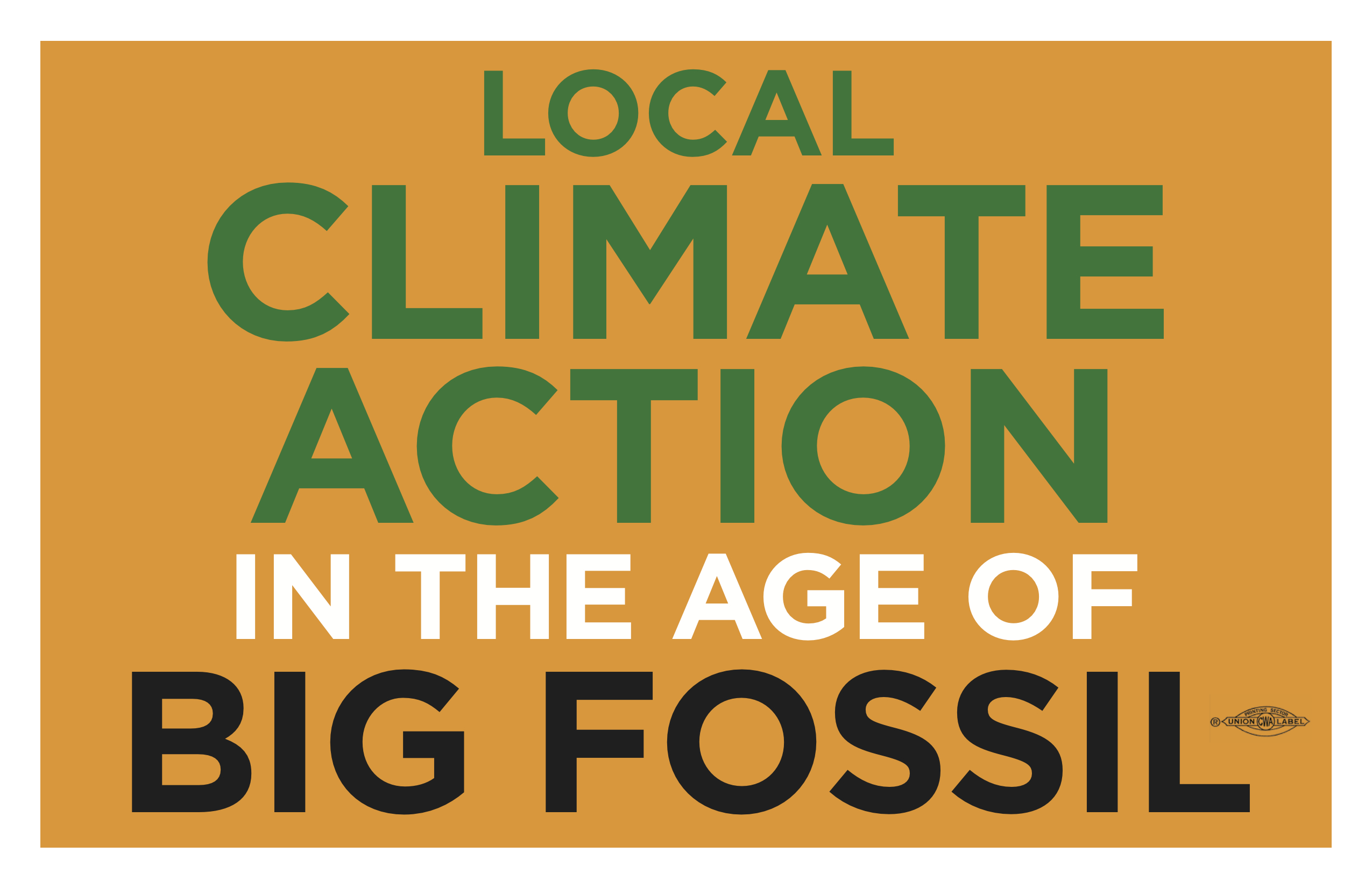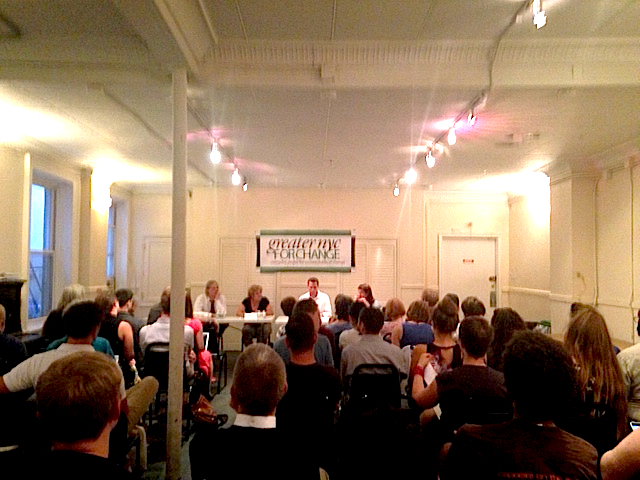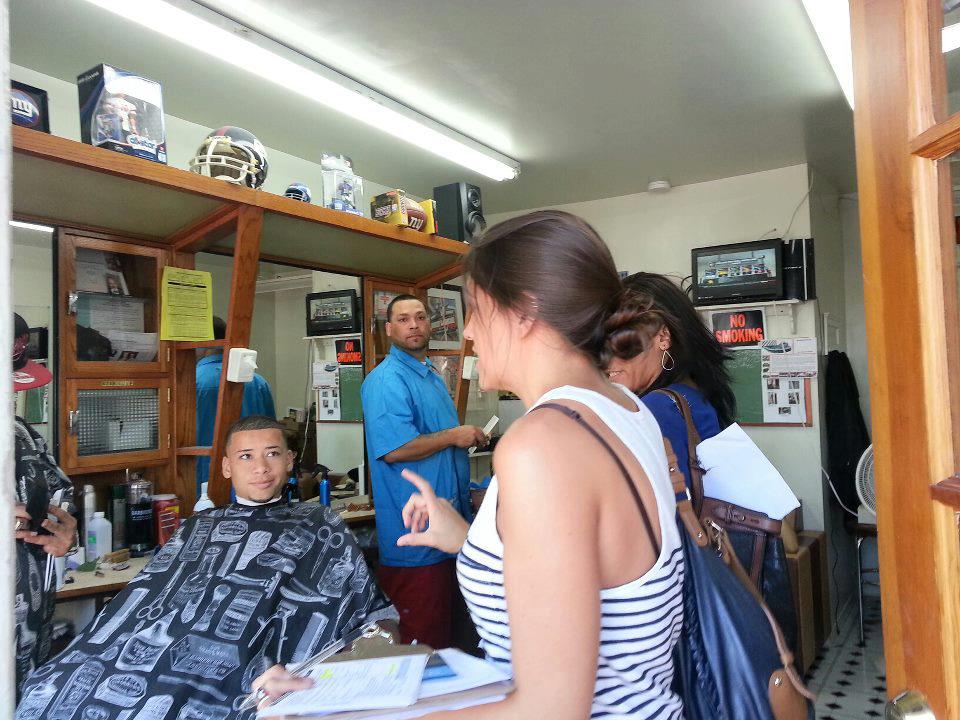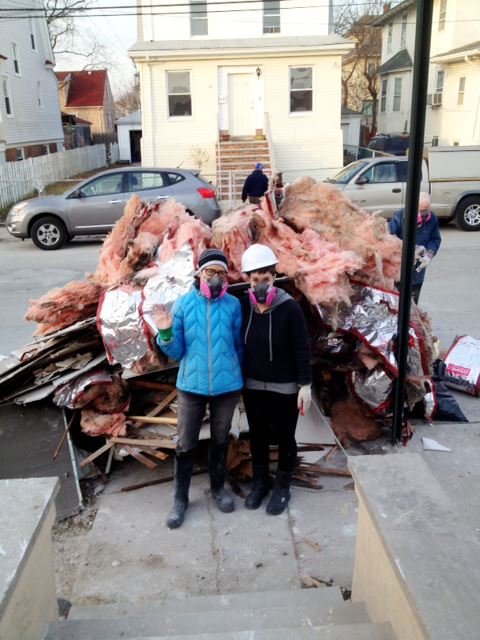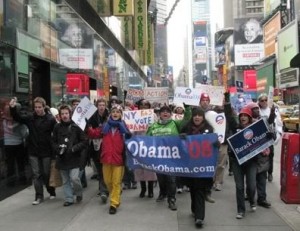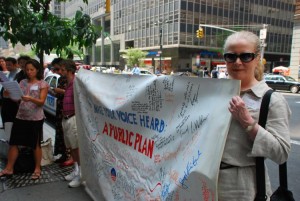Summaries, Resources, Actions
from the February 3rd Panel held St. John’s Lutheran Church, NYC. Many thanks to all for a constructive, engaged conversation. Below are summaries, resources, and actions from our panelists and remarks from our Moderator.
Beth Newcomer
The Legislative Analyst for NYC Council Member Helen Rosenthal (District 6, Upper West Side) encouraged attendees to reach out to their local Council Members and urge them to support the following legislative initiatives:
• Possible legislation regarding divestment of the city’s pension funds from fossil fuel companies
• A bill to require the city to do a carbon footprint analysis of all the products the city procures, and to use that analysis to inform a policy of low-carbon operations
• A number of bills to reduce the carbon emissions of city-owned vehicles and improve the sustainability of city buildings
• A bill to enhance the city’s already-strong idling laws so as to make them easier to enforce
Find your Council Member here.
Larry Schimmel
The General Counsel for Investment and Operations at the Office of NYC Public Advocate Letitia James noted his roles at the Public Advocate’s office and as Representative Trustee of the $54 billion New York City Employees Retirement System (NYCERS), conveyed the Public Advocate’s support of environmental causes, and noted her role as Trustee of NYCERS. Other highlights:
• City Council legislation, Intro 378, by Council Member Costa Constantinides (District 22, Queens), which mandates the City to reduce greenhouse gas emissions by 80% by 2050. Also working on this are Council Speaker Melissa Mark-Viverito and Council Member Donovan Richards (District 31, Queens; Chair of Environmental Protection Committee). Larry noted that the majority of the city’s emissions comes from buildings.
• After highlighting Gov. Cuomo’s recent ban on fracking, Larry expressed hope that the new leadership in the State Legislature will continue to support environmental initiatives.
• Larry provided an overview of the five NYC pension systems whose assets under City management total $160 billion. He outlined the relationship of the NYC Comptroller as Trustee and Adviser to the systems, and then discussed management of the NYS Common system run by State Comptroller DiNapoli, and NYS Teachers Retirement System. Larry stressed the importance of understanding the differences between people’s own monies, endowments, and Public Plans, as to the basis and motivations for their decisions and the laws they must follow. Trustees of public pensions have a fiduciary duty to realize expected returns. Trustees understand risks, and there are risks associated with specific fossil fuel companies and, of course, with climate impact.
• Larry cited several divestment precedents: Comptroller Jay Goldin’s efforts on apartheid in South Africa, via the Sullivan Principles; Public Advocate Mark Green’s efforts on Tobacco divestment; Comptroller Tom DiNapoli’s and Bill Thompson’s efforts on Sudan and Iran divestment; and, finally, then-Public Advocate De Blasio’s 2013 efforts on gun divestment.
RESOURCES
NYC Comptroller’s Office overview data on the City pension funds:
http://comptroller.nyc.gov/
NYCERS
NYS Common Pension
NYS Teachers Pension
Lisa DiCaprio
Speaking of behalf of 350NYC, the Clinical Associate Professor of Social Sciences at NYU made the central case for divestment of NYC’s pension funds:
Two hundred publicly held companies own the vast majority of fossil fuel reserves underground. Their reserves could become “stranded assets”—basically, assets that have lost their value. If we limit global warming to 2 degrees through government regulation and cheap and abundant clean energy, this essentially means roughly 80% of fossil fuels have to stay in the ground, devaluing these reserves. On the other hand, if there’s no limit to how much fossil fuel we burn, and we head toward 6 degrees of warming, then vulnerable sectors will be affected. Agriculture, infrastructure, property, and insurance sectors will suffer across asset classes. A local example: Hurricane Sandy caused $65 billion in damages alone, and wasn’t limited to the fossil fuel sector.
These two hundred companies are the target of the divestment movement. Their stock prices and business plans depend on digging up and burning these reserves, which would lead to an unsustainable increase in the average global temperature of between 6 and 12 degrees or more. If it’s wrong for these companies to wreck the planet, then it’s wrong to profit from that wreckage. As part of a worldwide campaign, 350NYC wants the City of New York to immediately freeze any new investment in fossil fuel companies, and divest from direct ownership of any commingled funds that include fossil fuel public equities and corporate bonds within five years.
Louis Berger
The co-founder and managing partner of Washington Square Capital Management discussed approaches to socially responsible investing (SRI):
1. Positive Screening: Investor looks for profitable companies that integrate environmental social governance (ESG) issues into their business practices and operations. Typically a company whose product or service and/or business practices actively address the following issues: environmental conservation, human rights, labor rights and fair trade. Example: a solar panel manufacturer.
2. Negative Screening: Investor excludes certain companies that do not place a high value on ESG criteria in their business practices, or provide products/services that undermine ESG issues. This approach often means eliminating entire industries like tobacco, weapons, or oil and gas. Example: an oil driller/refiner.
3. Best-in-Class Investing: Investor targets a progressive company within an industry likely to have a poor ESG track record. While the type of business may not be considered socially responsible, the way the company conducts its operations is the chief criteria. This investor rewards forward-looking and responsible corporate behavior with dollars. This approach is often used by pragmatic investors who are comfortable having some exposure in negatively screened sectors. Example: a utility company that is an industry leader in environmental conservation and alternative energy.
4. Activist Investing: Investor targets companies that may have poor CSR track records in the interest of changing the company’s business practices from the inside. This approach uses proxy votes and shareholder resolutions to pressure management to alter corporate behavior. This approach is most effective when used by large institutional investors (mutuals, pension funds, foundations) or a coalition of small-to-medium-sized investors. The activist investor may achieve long-term CSR victories when successfully petitioning a company to change its business practices.
5. Community/Impact Investing: The investor is less concerned about the financial returns of his/her investment than about the greater social impact. The main goal is to deploy investor capital to individuals, organizations, businesses or geographic regions that have historically been denied access to capital by traditional financial institutions. This approach is usually undertaken by larger institutions; individuals also take part through crowd-funding or microfinance.
RESOURCES
For DIY investors interested in picking socially responsible mutual funds,
socialfunds.com offers a fairly comprehensive list of mutual funds that incorporate social screening. SRI mutual fund companies: most are branded “socially and environmentally responsible,” but few are fossil fuel-free, since they incorporate best-in-class screening. Examples include:
www.calvert.com
www.parnassus.com
www.paxworld.com
www.domini.com
www.newalternativesfund.com
Tim Woodcock
The co-founder of HomeEdison noted the Renewable Energy (RE) sector’s ability to deliver alternative energy at substantially lower costs than standard utility rates; the importance of building a two-way energy supply infrastructure in order to allow homeowners and business to sell the excess energy their alternative installations generate back to the utility company; and the applicability of geothermal systems in much of our region. Other key points highlight the growth of the RE:
• In the RE sector, solar energy has grown by more than 400% in the last four years.
• Institutional investors such as Citi, Bank of America, and TIAA-CREF are placing big bets on RE.
• Sovereign Wealth Funds such as those in China and Saudi Arabia are placing nine-figure commitments to public sector development of RE.
• The “Green Bond” space has grown from a boutique $1B in 2011 to $36B in 2014, with an anticipated $100B of issuances this year. Technically, the total bond universe of clean infrastructure is $502.6B, when including rail, water infrastructure, etc.
• Funds committing to renewable energy investments early will reap the greatest rewards, especially as Barclays is downgrading the entire US utility sector.
Tim further noted that pension funds and endowments are aware of these trends, but they will need reminders from activists and activist shareholders alike. NYC will release a green bond this year, so Tim suggests writing Comptroller Scott Stringer to tell him you want to see distributed renewable energy generation: http://comptroller.nyc.gov/help/constituent-intake-form/
Moderator’s Remarks from Al Appleton, former Commissioner of the NYC Department of Environmental Protection and Senior Fellow at the Cooper Union:
When we talk about addressing global warming, we’re talking about disentangling 21st century society from fossil fuel. Is the right policy for global warming to seek an 80% emissions reduction by 2050, or to transition completely out of fossil fuels? There are powerful arguments for the latter, both environmental and pragmatic; it may actually be easier to accomplish by 2050. In any event, we’re talking about a profound transformation of society. If we’re to make it happen, we have to understand how we got here, and the kind of problem we’re facing.
The modern industrial era began in 1765, when James Watt invented the reciprocating steam engine, transforming the ability of humans to do work. Before, we did work with muscle power, animal power (horses, mules, donkeys, oxen, camels), wind power on the oceans and in gristmills, a little hydropower, and open fire. By harnessing heat power, Watt multiplied the ability of humans to do work by perhaps one hundredfold. Mr. Watt’s marvelous engines needed a fuel source to generate the heat that drove them. There wasn’t enough wood to meet the need, but fortunately nature has provided the planet with fossil carbon—first coal, then oil, then natural gas. So we encouraged the growth of fossil fuel production, recognized it was pivotal to our future, embedded it in our culture, bestowed fortunes upon those who provided it, and transformed our world. Without fossil fuel, our modern society is unthinkable. For 200 years—until the late 1960s and the emergence of the new environmental consciousness—we never looked back.
Today, the negative consequences of that embrace have become only too apparent. As the planet has continued to expand its use of fossil fuel and bring a Western lifestyle to all, the collateral damage has accumulated. The cost curve has crossed the benefits curve, and is now outgrowing it. In short, we are the victims of our own extraordinary success. Since 1765, the population of the planet has increased by a factor of ten, and our economic output by a factor of one hundred or more. In all these terms, which are ecological ones, fossil fuel has made us a success, but now we are about to become its victim.
Nothing is harder for humans than to turn their backs on success, but this is the nature of all great crises and turning points in human history. For example, about 15,000 years ago, we came out of the last Ice Age as amazingly skilled hunters; we had to be to survive its rigors. But, once released from its constraints, we flooded over the planet and, in 2000 years, we peeled the land of large game species (with the exception of Africa, where those species had time to co-evolve with us) and fueled a population boom that we could no longer feed by hunting. So, we developed agriculture and animal husbandry. Similarly, after 6,000 years of success in a Neolithic subsistence farming culture, we had once again produced more people than we could support, so we were driven to create cities and organize irrigated agriculture. Around 500 BC, we reached a point at which cities had been so successful that they could no longer produce enough food for themselves in their hinterlands; they had to turn to long-distance trade. From this rose the imperial trading empires of Western Europe, the Middle East, India, and China.
With global warming, we face a similar crisis of success; like all previous crises, it will require a transformative way of living, and the institutions and values necessary to support it.
We’re going to have to disentangle our economy, our society and our values from fossil fuel and the role we have given it. It won’t be easy and there’s no guarantee we can do it in time. When we meet obstacles, we must understand that every positive step is cumulative, that betting on the future is the right course. All but the most hardened climate deniers will admit that green energy is the future; but if we’re to make it the future, we must realize that those who promote and profit from fossil fuel are only doing what the world has asked of them for the last 200 years. If we’re going to reverse that process, we have to understand that, and stay focused on the future, not the past.
After Dasani: Shining Light on the Invisible
Tens of thousands of people–including a large number of children–go to sleep homeless in NYC. The numbers living in shelters has risen by 75% since 2002, while wealth has concentrated disproportionately. On July 8th, 2014, GNYCfC convened a panel discussion on homelessness and what has changed since Andrea Elliot’s inspiring New York Times series, “Invisible Child,” brought Dasani and thousands of children like her into focus. We addressed the urgency of the situation, Mayor de Blasio’s affordable housing plan, and ways that average citizens can fight back against the deepening crisis of homelessness. Our moderator was Ben Max of Gotham Gazette, and our panelists were:
- Heidi Schmidt, Public Affairs Manager Office of External Affairs, NYC Department of Homeless Services
- James Dill, Executive Director of Housing & Services, Inc.
- Lisa Lombardi, Deputy Executive Director of Urban Pathways
Following presentations and a Q&A, participants broke into groups to brainstorm solutions. The results and various resources:
Breakout Groups Actions:
- More transparency from the administration about city-owned property. Residential buildings should be listed and counted, then made available for housing the homeless. Refer to HPD
- Tax incentives/requirements for developers to include housing for homeless individuals. Refer to HPD Low Income Housing Tax Credits.
- Require property owners with vacant buildings make them available for homeless housing units.
- Push for stronger rent regulations. Questions: Could we pay people directly to rent their own apartments for less? How do we educate people about what homelessness really looks like? Which programs work and how can we replicate? Refer to DHS Temporary Housing Assistance.
- Re: getting people legal help for housing court, the New York County Lawyer’s Association has a pro-bono program where attorneys give free advice to walk-ins (see Resources).
- Taxing vacant lots/units. Identifying where system fails. Promote inter-agency collaboration.
- Stronger workforce development with homeless, and children, with better coordination between agencies. Community outreach teams to homeless or create a number/office that people can call other than the police (see resources, 311 app). Provide better training to NYPD.
Resources:
- Call 311 for outreach to homeless individuals. Download the 311 app.
- NYC DHS Homebase map of Homeless Prevention Network.
- Met Council on Housing Nonprofit tenant’s rights org. Resources for tenants, including legal. Walk-in clinic.
- New York County Lawyer’s Association
- CLARO NYC Civil Legal Advice and Resource Office provides limited legal advice to low-income New Yorkers being sued by debt collectors.
- New Alternatives Outreach to LGBT homeless youth.
- NYC Councilman (7, West Harlem) Mark Levine’s “Right to Counsel” Bill.
- A post from Bronx Defenders on this proposed legislation.
Housing New York: A Five-Borough, Ten Year Plan
An ambitious, weighty tome of principles and guidelines. The Mayor’s plan acknowledges that the current homelessness crisis is a subset of the affordable housing crisis. We all eagerly await further details. Specifics addressing homelessness begin in Ch 4, p 78.
NYC Homeless/Permanent Supportive Housing Advocacy Groups:
- Supportive Housing Network of New York
- United to End Homelessness NYC
- Campaign 4 NY/NY Housing & Services
2013: Milestones
Thanks to the energy, support, and dedication of volunteers, organizers and partners, Greater NYC for Change had a milestone 2013. As we officially incorporated as a non-profit advocacy organization, we continued to advocate, inform, promote progressive policy, and fundraise for vital causes.

ADVOCACY
2013 was also a milestone year in Health Care — thanks in part to the advocacy of Health Care for all New York, our state exchange, New York State of Health, went live! Greater NYC for Change led enrollment training sessions, and volunteers participated in sign-up events throughout the city. Working with the Get Covered New York campaign, we reached thousands of uninsured New Yorkers. We were honored when Sandra Fluke and Tim Foley of SEIU Healthcare joined forces to guide and inspire volunteers. The results of your unwavering support for the ACA? By year’s end, well over 165,000 New Yorkers enrolled in Qualified Health Plans, and a total of over 230,000 individuals signed up for insurance. Those figures (which are growing by the minute) include thousands of previously uninsured children and youth.

This time last year, you told us that your #1 priority is Economic Justice. The issue is recognized in many quarters as the great challenge of our day. We continued to advocate for a Living Wage and Paid Sick Leave legislation. On Immigration Reform, we participated in the New York DREAM Act Albany Day of Action, in collaboration with NYSYLC.
We’re poised for great strides in Education: Mayor de Blasio has garnered strong support for universal Pre-K, and the initiative has now been taken up for New York State by Governor Cuomo. We continue to partner with Alliance for Quality Education to promote their comprehensive legislative agenda statewide.
When unbearable heartbreak struck our neighbors in Newtown, CT, New York State quickly passed the toughest gun control laws in the nation. Governor Cuomo deserves credit here for decisive action, as do our partners at New Yorkers Against Gun Violence, who continue to push for results state- and nationwide.
CAMPAIGNS
It was a milestone year for New York City politics, with the election of a roster of progressives — Mayor Bill de Blasio, the first Democratic mayor in 20 years; Public Advocate Leticia James; and Comptroller Scott Stringer. Greater NYC for Change focused on engaging candidates on important issues to elevate our political discourse, and we’re delighted with the results.

FUNDRAISING
Greater NYC for Change fundraised for the Food Bank of NYC, which has done exceptional work under the increased challenges of reductions to SNAP benefits. The group was recognized by Governor Cuomo and named 2013’s New Yorkers of the Year by NY1.
2014: The Way Forward
All of this brings us to today, and the way forward. We’ll continue to partner strategically and effectively. On Health Care, we’ll continue to educate, inform, and help enroll, so as to bring affordable care to all New Yorkers. The tide is turning on Economic Justice, with overwhelming public support for living wages and paid family leave. Immigration will be a tough slog, but as a city of immigrants, we’ll keep the fire. We’ll also partner with Fair Elections for New York in their efforts to pass meaningful campaign finance reform in the state. Let’s make 2014 a year of more milestones!
2012: What You Accomplished
Thanks to the energy, passion and dedication of volunteers, organizers and partners, GNYC4C had an active and engaged 2012: making strides in advocacy, advancing progressive candidates, and fundraising for worthy causes. As we extend our thanks to you who make this possible, we want to listen to you, too. Tell us what you want GNYC4C to focus on in 2013!
ADVOCACY
On Health Care, we partnered with the New York Health Care for All Campaign to press for the formation of a state Health Care Exchange; our friend Tim Foley of the SEIU led valuable learning sessions. We prepared for battle when the Supreme Court ruled on the ACA, and instead got to celebrate when they upheld the law. To enable effective citizen advocacy, we hosted a Messaging and Press training session with progressive powerhouses T.J. Helmstetter and Amy Spitalnick.
GNYC4C continued the push for Economic Justice, supporting the Living Wage Campaign and Paid Sick Leave legislation. In Education, we partnered with the Alliance for Quality Education to protest cuts in the State’s education budget and call for increased funds for pre-K and high-needs programs. We hosted a forum with Congressman Jerry Nadler (NY-15) on the Economy, filibuster ramifications, and women’s rights; and our resident economics guru Ethan Rips hosted learning sessions comparing the respective budgets of the two Presidential candidates.
As a picture of devastation from Sandy emerged, our activists did not rest. In partnership with Manhattan Young Democrats and the Office of Senator Joe Addabbo (NY-15) we canvassed to assess conditions and medical needs in hard-hit Hamilton Beach. With Occupy Sandy and the Transit Forward Coalition, we coordinated bus trips to the Rockaways to support clean-up and relief efforts, and spearheaded an effective petition campaign to demand action from elected officials.
CAMPAIGNS
GNYC4C partnered with organizations such as ACT NOW, MYD and Village Independent Democrats to drive meaningful volunteer action on key contests. We created new channels for volunteer outreach at events such as Brooklyn’s Caribbean Day Parade and Atlantic Antic. Our coalition supported the re-election of President Obama in the swing state of Pennsylvania. These efforts faced the additional hurdle of keeping abreast of the state GOP’s discriminatory Voter ID tactics. While OfA-NY focused on Philadelphia, our coalition, in a parallel effort, targeted closely contested Northampton and Lehigh Counties, coordinating voter registration drives, phone banks and canvass bus trips. The frequency of bus trips intensified in the lead-up to the election, with many volunteers committing days on the ground for vote drives. Our strategy worked! The President carried both counties, 52-47 and 53-47, respectively.
Through phone banks and canvassing, GNYC4C also supported the US House campaign of Democrat Sean Patrick Maloney in NY-18 (Cold Spring). Maloney defeated Tea Partier Nan Hayworth, despite her PAC-supported fundraising advantage. In the US House campaign in NY-11 (Staten Island), Mark Murphy was narrowly defeated by the incumbent. In the State Senate race in NY-40 (Dutchess/Putnam/Westchester Counties) we supported the campaign of Justin Wagner, who was narrowly defeated by Tea Party-friendly Greg Ball.
FUNDRAISING
GNYC4C organized successful fundraisers benefiting City Harvest and the Food Bank of NYC.
2013: The Way Forward
In a milestone for our organization, GNYC4C filed articles of incorporation with New York State to become a 501(c)4 non-profit. Pending final approval, this step forward will amplify your voice and help us better serve worthy causes. This brings us to today, and the way forward. Your survey responses will help us to set priorities in the year ahead.
2011: Year in Review
Here are some of the events Greater NYC for Change hosted in 2011! This was the year we helped the effort to pass microstamping and stood up for education funding in New York. We also helped elect a progressive Member of Congress in upstate New York.
December 14th, 2011, 7 PM: Holiday Happy Hour
As this year draws to a close, we would like to say thank you for all your spirited efforts with our annual holiday happy hour at Nightingale’s. Together with ACT NOW, we will be celebrating an unprecedented year of action with food, drink specials ($4 beers and $6 well drinks until 9pm) and a special musical performance by iKhanik! Nightingale Lounge / 213 Second Avenue, NW Corner of 13th St. and 2nd Ave, New York, NY
December 11th, 2011, 1-3 pm: Public Education Teach-In: The ABCs of the Millionaire Tax Impact on the NY State Budget
Greater NYC for Change invites you to join a teach-in discussing the effect of the expiration of the millionaire’s tax on the public education budget. Julian Vinocur of Alliance for Quality Education will be speaking about this critical issue. Ideas will be shared regarding how we can stand up for education in New York State. Damaging budget cuts have already led to overcrowded classrooms and made it difficult for many students to attain the meaningful education they deserve. Join us and help move this essential conversation forward!
November 17th, 2011, 5 PM: 99% Day of Action (Foley Square)
November 17th is the two-month anniversary of Occupy Wall Street. Early on Tuesday morning the heart of the Occupy movement was evicted from its Zuccotti Park home by people who do not want to hear the voices of the 99%. But you cannot evict an idea whose time has come. Today Greater NYC for Change joins thousands of New Yorkers who will leave classrooms and jobs early to be together at Foley Square in Lower Manhattan. We join Occupy Wall Street along with unions and dozens of other community organizations to reclaim our democracy. Together, we will speak freely about the economic emergency we face while our political system remains largely in the hands of the 1%.
September 8th, 2011, 7 – 9 PM: Gathering in Remembrance of 9-11
Join the New York Neighbors Coalition in a gathering of remembrance of and reflection on the 10th anniversary of September 11th. Participating organizations include Common Cause, the NYCLU, and the New York Taxi Workers Alliance. Speakers include Broadway legend Andre DeShields. Folks will be gathering on the corner of Church and Park from 7 – 9 PM.
September 8th, 2011: Weprin Campaign Volunteering
Some of you may be following the election to replace former Rep. Anthony Weiner that will be held on Sept. 13th, in conjunction with a number of primaries and special elections throughout the city. We believe that Democrat David Weprin will be a solid vote on issues that matter–a pro-choice, pro-marriage-equality politician. The latest from his opponent? Bob Turner says, “I never met a tax loophole I didn’t like,” a surprising position to take in these challenging economic times. Join us in making sure these words are not uttered from the next Congressmen from New York’s 9th district. Greater NYC for Change organized phone banks at Gillibrand’s office in Manhattan.
July 20th, 2011: “Restore the American Promise” Ferry Ride
Social Security, Medicare, Medicaid. You know, the Big Three. Not to mention the new Affordable Care Act. Join us this Wednesday, July 20th. We’re meeting at 3:45 PM on the Manhattan side of the Staten Island Ferry to take the 4:00 PM boat over to the Staten Island Borough Hall (right across from the ferry terminal on the S.I. side) for a 4:30 PM rally and press conference to tell Rep. Michael Grimm (R-Staten Island) that cutting Social Security, Medicare, or Medicaid betrays OUR idea of what America can live up to. Especially when money going to oil companies, GE, and other large corporations through loopholes in our tax code could change the direction of those resources toward those who truly need it. Our trip to Staten Island is part of “Restore the American Promise,” a statewide campaign comprised of a coalition of health care advocates, unions, and other progressive organizations determined to save our social safety net.
July 14th, 2011: Summer Social
Join Greater NYC for Change and ACT NOW this Thursday, July 14th, at Bar 13, located at 35 East 13th Street & University. We’d love a strong turnout and hope you can make it! There will be two-for-one drink specials until 9pm as well as delicious snacks.
June 7-9, 2011: Microstamping Phone Banks
Greater NYC for Change is teaming up with New Yorkers Against Gun Violence and other grassroots groups to hold Microstamping phone banks this week. Join us in making phone calls to constituents of swing votes in the NY State Senate. Microstamping rests in the hands of these few state senators, and they need to hear from their constituents! Tuesday, June 7th, 6 – 9 PM & Thursday, June 9th, 6 – 9 PM. Co-Sponsors: Brooklyn for Barack, Democracy for New York City, Downtown East for Obama, Greater NYC for Change, New Yorkers Against Gun Violence, Tribeca for Change and UWS Democrats for Progress.
June 1st, 2011, 6:30 PM – 8:30 PM: Messaging Workshop: The Ryan Budget Is a Winner — For Democrats!
Republican Representative Paul Ryan gave Democrats a huge gift when he proposed his radical- right budget. His plan, which includes the total dismantling of Medicare, shows the clear distinction between the two parties. And as the race in NY-26 just proved, voters don’t like what Ryan and the Republicans plan to do if they gain power. So how do we make sure all Americans know what’s at stake in 2012?
Join Greater NYC for Change’s Tim Foley and the Downtown East Messaging Group for an informative presentation and discussion on how we frame the debate and win big in 2012. We will focus on the Republican agenda as represented by the Ryan budget plan and other recent actions. We’ll work together to develop our strongest arguments for convincing voters which party is truly looking out for their interests.
May 2011: Help Elect Kathy Hochul!
May 24th is Special Election Day for NY-26 in upstate New York. The Democrat, Kathy Hochul is running for Congress in a deep red district on a brave campaign of standing up against the Paul Ryan budget and its plans to scrap Medicare. The race has taken some truly crazy turns.
The seat was vacated by the Republican Chris Lee. (You may remember his formidable abdomen from photographs). The polls are incredibly close, and Hochul has a very small lead. As a final push, we have set up phone banks on Monday and Tuesday to make sure voters in Kathy’s district get to the polls! Please bring your cell phones and rechargers. Those who want to make calls from home can go to www.callny26.com.
2009 & 2010
Brooklyn Bridge March
February 20, 2010
Hundreds of New Yorkers walked across the Brooklyn bridge to rally for health care reform, ending up at the headquarters of Wellpoint Insurance. Organized by Greater NYC for Change and the “Health Care for America Now!” coalition.
Video: CBS 2 News, Next Left Notes
Photos: Flickr Album
Articles: Islanders take part in citywide march for health care reform – Staten Island Advance
A Beautiful Day to March Across the Brooklyn Bridge – DailyKos
Hundreds March for a Public Option – Pix 11
Reddit – Over 25,000 views. We were the #10 story that day!
Times Square Rally
August 30, 2009
As the funeral and burial of Senator Edward Kennedy was held Saturday, thousands took to the streets of Manhattan to call for health care reform. Speakers at the rally thanked Kennedy for his years of work pushing for health care for all Americans and said the fight must go on. Organized by Greater NYC for Change and the “Health Care for America Now!” coalition.
Video: NY1
Don’t Stop Til You Get Enough Health Care! – Youtube
Photographs: Slide Show: Health Care Rally in Times Square – New York Times
Articles:
Saturday Health Care Rally at Times Square – New York Times
Rally for Health Care in Times Square – DailyKos Photodiary by bria
As Ted Kennedy is laid to rest, Democrats to hold massive healthcare rally in NYC – examiner.com
Health Care Rally in Times Square Tomorrow – Gothamist
1,000 Attend Health Care Rally In Times Square – Gothamist (photos)
Rally for health care reform in Times Square – Examiner.com
R A L L Y T I M E !! – Dailykos article by casperr
3000 NYers RALLY for Health Care in Times Square UPDATED x3 – Dailykos article by casperr
Up to 1,000 Rally in NYC for Health Care Bill – Huffington Post
Nine Inch Nails & Alyssa Milano tweeted & promoted the rally. Thank you!
2,500 Postcards Support Health Insurance Reform
July 29, 2009
In the summer of 2009, Greater NYC for Change, in partnership with a coalition of grassroots groups, collected 2,500 personal accounts to demand health care reform legislation by the end of the year. On July 29, 2009, 1,500 postcards from New Yorkers, each telling a story, were delivered to Sen. Charles Schumer’s (D-N.Y.) New York office to encourage his continued support of President Obama’s health insurance reform.
Read more about it here: 1,500 Postcards Support Health Insurance Reform – The Epoch Times
Capitol Hill Rally
June 25, 2009
 Greater NYC for Change and the “Health Care for America Now!” coalition organized 140 people to travel to Washington, D.C. to take direct aim at health insurance companies. Thousands of union workers, doctors and other health care reform supporters formed a united front against the industry and demanded a government-sponsored health insurance option. It was the largest rally in support of reform in history, at that time.
Greater NYC for Change and the “Health Care for America Now!” coalition organized 140 people to travel to Washington, D.C. to take direct aim at health insurance companies. Thousands of union workers, doctors and other health care reform supporters formed a united front against the industry and demanded a government-sponsored health insurance option. It was the largest rally in support of reform in history, at that time.
Read more about the New Yorkers here: 10,000 Strong for Healthcare Reform in DC – APA for Progress
Articles: Liberals Demand “Public Option” At Capitol Hill Rally – CBS News

